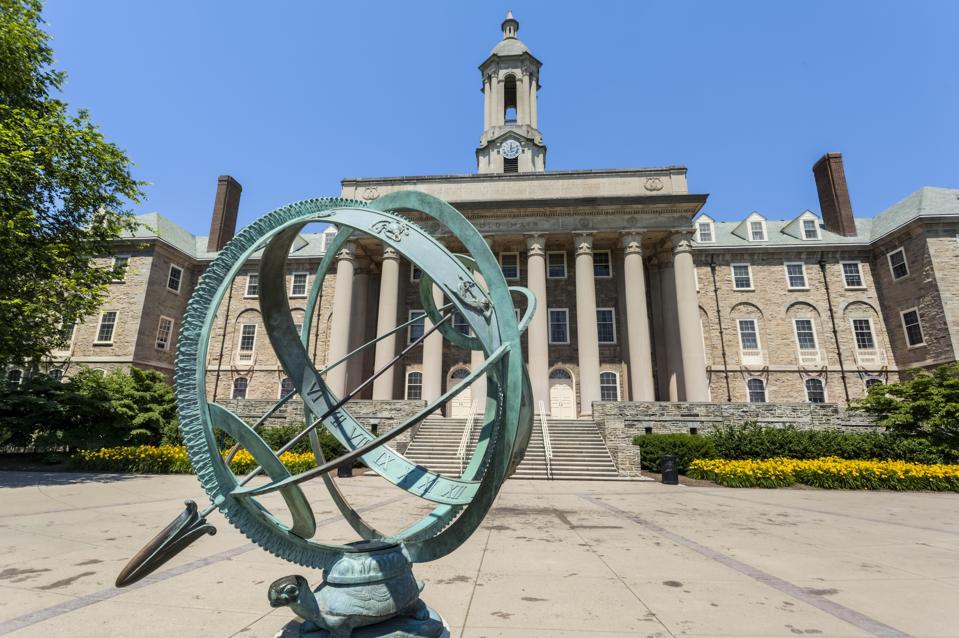Higher education’s budget woes are far from over. Within the past two weeks, three major public institutions – each one the flagship university within its state – have announced plans for significant budget cuts, part of a continuing effort to cope with sagging enrollments, inflated costs and stagnant state funding.
Here’s a summary of what the three schools – Pennsylvania State University, the University of Connecticut and the University of New Hampshire – have revealed about their budget reductions.
Having disclosed in a memo sent to campus leaders last February that the institution faced a general funds budget deficit of $140 million, administrators at Penn State University described the university as being “in a vulnerable state” at the time.
This week, Penn State President Neeli Bendapudi said the university must overcome its budget deficit, adding, “these are not one-time challenges or situations that are going to go away. These complexities require a new way of thinking and working to maintain our longstanding commitment to greatness at scale.”
Bendapudi reported that overall enrollment was down and that Penn State had 18 months to to determine what it must cut and where it should invest.
For fiscal year 2025-26, she said the university was considering cuts of $29 million for administrative and student support units, $11 million in reductions for the academic colleges at the University Park campus and $54 million in cuts for the other Penn State campuses across the Commonwealth.
“The need for change within our University is undeniable and must occur for Penn State to retain its status as a leading institution, to innovate, and to invest in greatness at scale in education and research,” Bendapudi said. “Our ability to respond to the multitude of challenges and our capacity to adapt is what will determine our success now and in the future.”
At the University of Connecticut, the current estimate is that it faces a $70 million deficit for fiscal year 2025 in addition to a $29 million hole for UConn Health, the institution’s health care system and hospital.
As a result, administrators are laying out a plan that would reduce the university’s operating budget by a cumulative 15% over the next five years. The plan begins with a 3% cut next year, followed by additional annual reductions of 4%, 3.5%, 2.5% and 2% through fiscal year 2029.
According to the Hartford Courant, University of Connecticut faculty are planning to picket today to protest the proposed cuts, which they say will likely eliminate graduate programs, increase class size and faculty workloads, reduce course offerings and require a scaling back of student support services.
According to a brief from the University of Connecticut branch of the American Association of University Professors, the plan constitutes a “severe threat to UConn’s standing as an R1 University… with implications for future accreditations.”
The University of New Hampshire (UNH) announced it would lay off approximately 75 employees, most of whom are apparently non-faculty staff, as it tries to cut expenses by $14 million.
According to an email to the university community, reported by Higher Ed Dive, UNH President James Dean, who plans to retire this June, wrote, “We know these challenges will persist in the coming years, and we must act to ensure that UNH is on firm financial footing to weather the challenges ahead.”
Acknowledging the terminations will have “profound effects on the impacted individuals and their families,” Dean indicated more cuts could be on the way, including “stopping some practices, consolidating some offices, and ending some programs and activities.”
It has been clear for some time that higher education’s budget difficulties are no longer confined to just community colleges, regional public universities, and small, private colleges. Financial crises are becoming more and more common at major public and private universities, who are discovering that merely shaving some costs might not be a sufficient strategy to deal with a longer-term problem.
Instead, as Penn State’s Bendapudi has observed about the difficulties faced by her institution, higher education’s “entire business model” needs scrutiny, including how much subsidy universities provide to their nonacademic activities, how much they spend on academic programs that are under-enrolled and losing revenue, and how they can transform the curriculum to produce better student learning.
Budget cuts may be necessary, but unless they are accompanied by more fundamental changes in how universities operate, they will not result in the improved financial viability American colleges and universities so clearly needs at this time.

